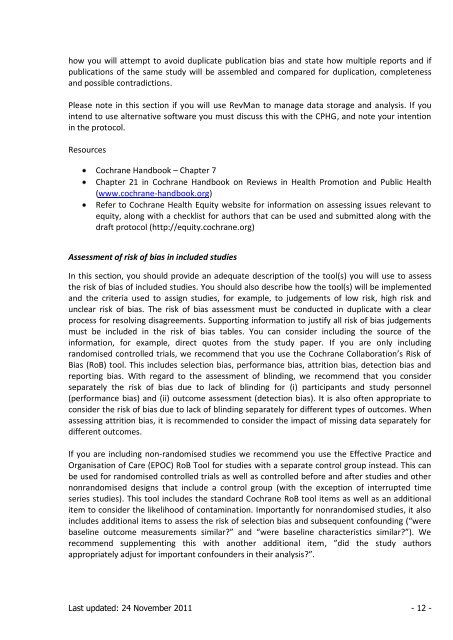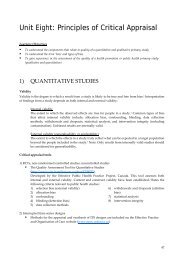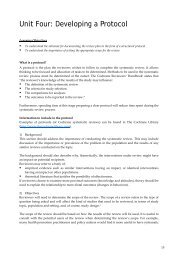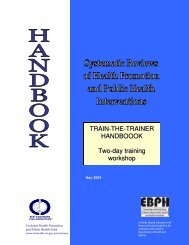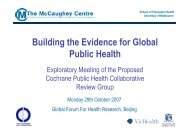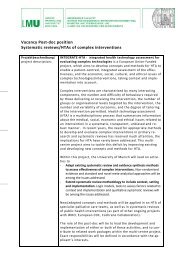Guide for Developing a Cochrane Protocol - Cochrane Public Health ...
Guide for Developing a Cochrane Protocol - Cochrane Public Health ...
Guide for Developing a Cochrane Protocol - Cochrane Public Health ...
You also want an ePaper? Increase the reach of your titles
YUMPU automatically turns print PDFs into web optimized ePapers that Google loves.
how you will attempt to avoid duplicate publication bias and state how multiple reports and if<br />
publications of the same study will be assembled and compared <strong>for</strong> duplication, completeness<br />
and possible contradictions.<br />
Please note in this section if you will use RevMan to manage data storage and analysis. If you<br />
intend to use alternative software you must discuss this with the CPHG, and note your intention<br />
in the protocol.<br />
Resources<br />
<strong>Cochrane</strong> Handbook – Chapter 7<br />
Chapter 21 in <strong>Cochrane</strong> Handbook on Reviews in <strong>Health</strong> Promotion and <strong>Public</strong> <strong>Health</strong><br />
(www.cochrane-handbook.org)<br />
Refer to <strong>Cochrane</strong> <strong>Health</strong> Equity website <strong>for</strong> in<strong>for</strong>mation on assessing issues relevant to<br />
equity, along with a checklist <strong>for</strong> authors that can be used and submitted along with the<br />
draft protocol (http://equity.cochrane.org)<br />
Assessment of risk of bias in included studies<br />
In this section, you should provide an adequate description of the tool(s) you will use to assess<br />
the risk of bias of included studies. You should also describe how the tool(s) will be implemented<br />
and the criteria used to assign studies, <strong>for</strong> example, to judgements of low risk, high risk and<br />
unclear risk of bias. The risk of bias assessment must be conducted in duplicate with a clear<br />
process <strong>for</strong> resolving disagreements. Supporting in<strong>for</strong>mation to justify all risk of bias judgements<br />
must be included in the risk of bias tables. You can consider including the source of the<br />
in<strong>for</strong>mation, <strong>for</strong> example, direct quotes from the study paper. If you are only including<br />
randomised controlled trials, we recommend that you use the <strong>Cochrane</strong> Collaboration’s Risk of<br />
Bias (RoB) tool. This includes selection bias, per<strong>for</strong>mance bias, attrition bias, detection bias and<br />
reporting bias. With regard to the assessment of blinding, we recommend that you consider<br />
separately the risk of bias due to lack of blinding <strong>for</strong> (i) participants and study personnel<br />
(per<strong>for</strong>mance bias) and (ii) outcome assessment (detection bias). It is also often appropriate to<br />
consider the risk of bias due to lack of blinding separately <strong>for</strong> different types of outcomes. When<br />
assessing attrition bias, it is recommended to consider the impact of missing data separately <strong>for</strong><br />
different outcomes.<br />
If you are including non-randomised studies we recommend you use the Effective Practice and<br />
Organisation of Care (EPOC) RoB Tool <strong>for</strong> studies with a separate control group instead. This can<br />
be used <strong>for</strong> randomised controlled trials as well as controlled be<strong>for</strong>e and after studies and other<br />
nonrandomised designs that include a control group (with the exception of interrupted time<br />
series studies). This tool includes the standard <strong>Cochrane</strong> RoB tool items as well as an additional<br />
item to consider the likelihood of contamination. Importantly <strong>for</strong> nonrandomised studies, it also<br />
includes additional items to assess the risk of selection bias and subsequent confounding (“were<br />
baseline outcome measurements similar?” and “were baseline characteristics similar?”). We<br />
recommend supplementing this with another additional item, ”did the study authors<br />
appropriately adjust <strong>for</strong> important confounders in their analysis?”.<br />
Last updated: 24 November 2011 - 12 -


